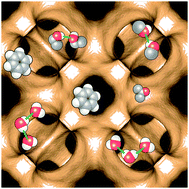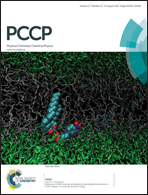Separation of benzene from mixtures with water, methanol, ethanol, and acetone: highlighting hydrogen bonding and molecular clustering influences in CuBTC†
Abstract
Configurational-bias Monte Carlo (CBMC) simulations are used to establish the potential of CuBTC for separation of water/benzene, methanol/benzene, ethanol/benzene, and acetone/benzene mixtures. For operations under pore saturation conditions, the separations are in favor of molecules that partner benzene; this is due to molecular packing effects that disfavor benzene. CBMC simulations for adsorption of quaternary water/methanol/ethanol/benzene mixtures show that water can be selectively adsorbed at pore saturation, making CuBTC effective in drying applications. Ideal Adsorbed Solution Theory (IAST) calculations anticipate the right hierarchy of component loadings but the quantitative agreement with CBMC mixture simulations is poor for all investigated mixtures. The failure of the IAST to provide reasonable quantitative predictions of mixture adsorption is attributable to molecular clustering effects that are induced by hydrogen bonding between water–water, methanol–methanol, and ethanol–ethanol molecule pairs. There is, however, no detectable hydrogen bonding between benzene and partner molecules in the investigated mixtures. As a consequence of molecular clustering, the activity coefficients of benzene in the mixtures is lowered below unity by one to three orders of magnitude at pore saturation; such drastic reductions cannot be adequately captured by the Wilson model, that does not explicitly account for molecular clustering. Molecular clustering effects are also shown to influence the loading dependence of the diffusivities of guest molecules.



 Please wait while we load your content...
Please wait while we load your content...